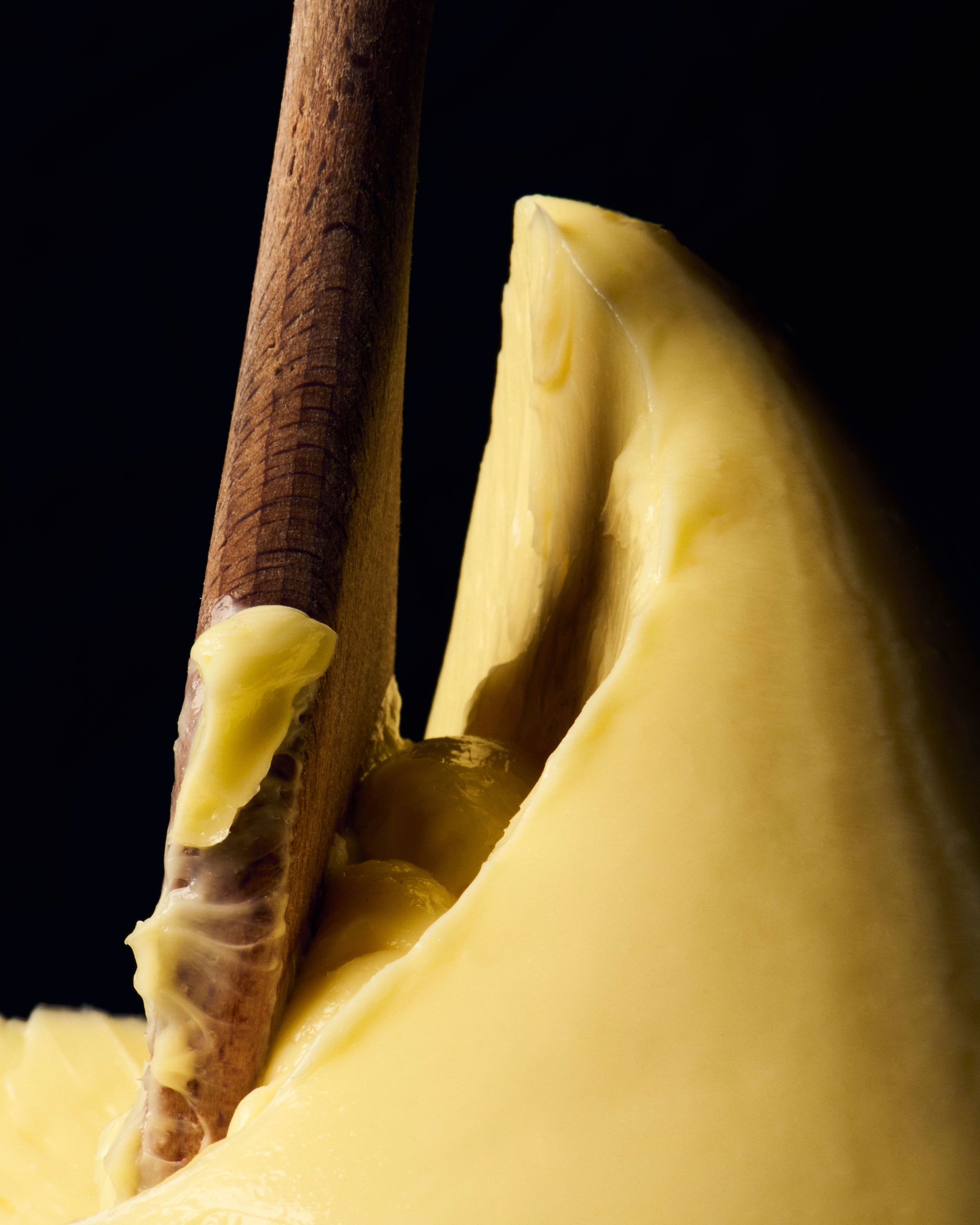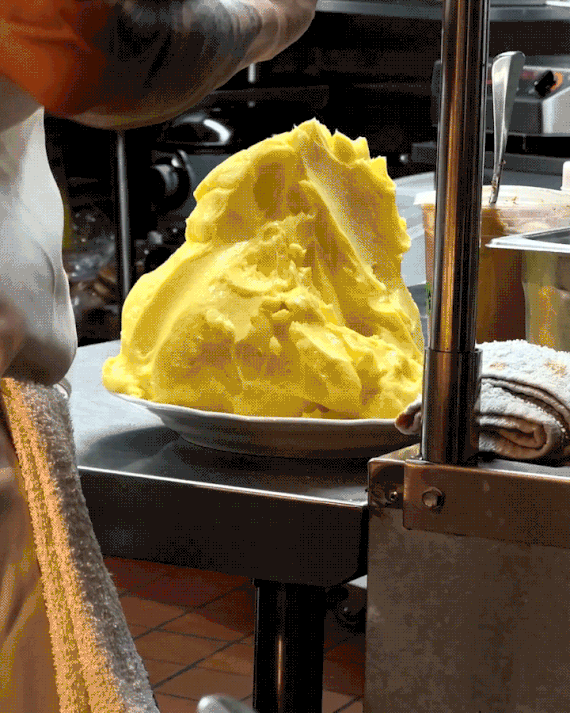when you want, where you want.
How Butter Became the Main Character
 Butter that’s served from a rolling cart at Quality Bistro.Photo: Hugo Yu
Butter that’s served from a rolling cart at Quality Bistro.Photo: Hugo YuOn Super Bowl Sunday, as Usher strode onto the halftime stage in a bejeweled tank top for more than 123 million viewers, all eyes inside the New York City bistro Libertine were on a different celebrity: It stood about 14 inches tall, was the same shade of pale yellow as a baby chick, and every few minutes, an expediter would spin around to dig a spoon into its soft sides. It was a mound of lightly salted butter imported from Normandy and by 8:30 p.m., 27 orders had gone out. That was on “a very slow night,” one server reported. A few minutes later, the 28th order landed on a two-top. A pair of men fell silent, locked eyes, and each swiped a curl onto a hunk of baguette. One appeared to moan as he took a bite.
When the restaurant opened last summer, it became clear almost immediately to chef Max Mackinnon that the pile of room-temperature, wood-churned Rodolphe Le Meunier butter, displayed in the center of the open kitchen, had become an object of great intrigue. It wouldn’t look out of place in Paris or Copenhagen, but in the West Village, an oversize mountain of butter felt almost cartoonishly opulent. Diners had questions, about its provenance — and whether they could pose with it for a selfie.
While butter has always been a fixation for a certain type of detail-obsessed chef, it has — traditionally — been largely taken for granted by diners. Its dietary benefits and drawbacks fall in and out of favor, and the most attention paid to it at the American table tends to be when a pat is too cold to spread across bread. But the enthusiasm for Libertine’s butter is part of a growing national interest across all sorts of dining establishments: Butter is no longer a supporting player. It has become a star, and it isn’t going to move out of the spotlight anytime soon.
Around the country, tureens of butter — of noble pedigree or stippled and topped with luxury ingredients — have become the new norm. Once a week, chef Brad Cecchi and his team at the East Sacramento restaurant Canon have been slow-cooking five pounds of cheddar with local butter for three hours, until the cheese fat melds with the rest of the dairy. Later, cooks season the butter with kombu, dehydrated garlic, nutritional yeast, and dried shiitake mushrooms, and top it with tater-tot scraps and chives. Its texture is like a Cheez-It chopped salad. “People know that it’s a sinful kind of thing,” says Cecchi. Recently, he says, a visitor from France turned to him after demolishing an order and said, “That was a filthy, dirty, delicious mess.”
We’re butter-maxing, in part, because it feels good to regress. “It’s like why everyone’s putting a fancy baked potato on their menu — kitschiness is coming back,” says the chef Donald Hawk, who renders down guinea-hen skin and whips it with fresh butter to serve with honeycomb and a white Sonoran wheat pretzel at Valentine in Phoenix.
At MaMou, in New Orleans, a pretzel batard comes nestled next to a crystal dish of tempered, cold-smoked Plugrà, whipped with piment d’Espelette and coated in a mossy dusting of blitzed herbs. “One of my employees actually jokes that she wants to be enveloped in the butter after death,” says executive chef Tom Branighan. Meanwhile, in Las Vegas, guests at Stanton Social Prime can order a disk of soft butter topped with tiny crudités and flaky salt, served within a smoke-filled cloche that’s lifted tableside. It costs $18.
“Even bread is good on its own,” says Alex Wilmot, an owner of Gigi’s in Los Angeles, where the cultured butter topped with caviar costs $32. “But people like indulgence — they were cooped up in their home for so long, they want a show.”
Does butter’s appeal really need to be explained? Perhaps the most surprising aspect of this development is that it took so long for people to admit they wanted butter to become a main-character ingredient. It’s a food that can be spread across a board and topped with flaky salt, and doing so on camera will make all of the thumbs that follow you tap the little heart icon. If bread is about humility and labor — you only have to look at it to know that someone spent days turning modest ingredients into a loaf — butter is excess incarnate.
 Libertine’s mountain of butter.Photo: Hugo Yu
Libertine’s mountain of butter.Photo: Hugo YuThat wasn’t always the case. Experts are iffy on its exact origin story, though “It was an important foodstuff because it’s shelf stable and gives the consumer calories incredibly quickly,” according to food historian K.C. Hysmith. Around the Middle Ages, it became a social signal, especially in Europe where cows were not indigenous, says Hysmith. In the 15th century, the Catholic church introduced a tax for wealthy acolytes who wished to recuse themselves from the butter ban imposed during lent, and butter became linked to wealth.
Butter arrived in America in 1607, and eventually made its way to state fairs, where sculptors turned it into expansive advertisements for local agriculture. Many centuries later — after Dan Barber introduced “single-udder butter” (a tasting dish of butters, each from a different cow), but before Butter Dawg picked up steam on TikTok by subsisting of a diet mostly comprised of full sticks — recipe developer Justine Doiron introduced the U.S. to the butter board. About a year and a half ago, she posted a tutorial of a Joshua McFadden recipe in which she swooshed room temperature butter over the surface of a toast-shaped cutting board, so guests could dip bread directly into it. She topped the butter with salt, lemon zest, red onion, and edible flowers. “It’s way more affordable than a charcuterie board, and it still comes out like a showstopper,” wrote Doiron in her accompanying blog post. Indeed, it all but paralyzed certain corners of the internet; it was as festive as a birthday cake but exponentially more executable. “I can’t wait to spend $16 on this at a restaurant in 6 months
All Rights Reserved. Copyright , Central Coast Communications, Inc.